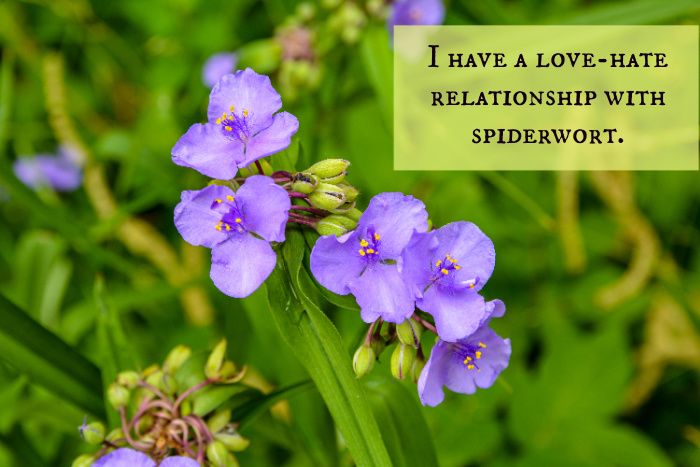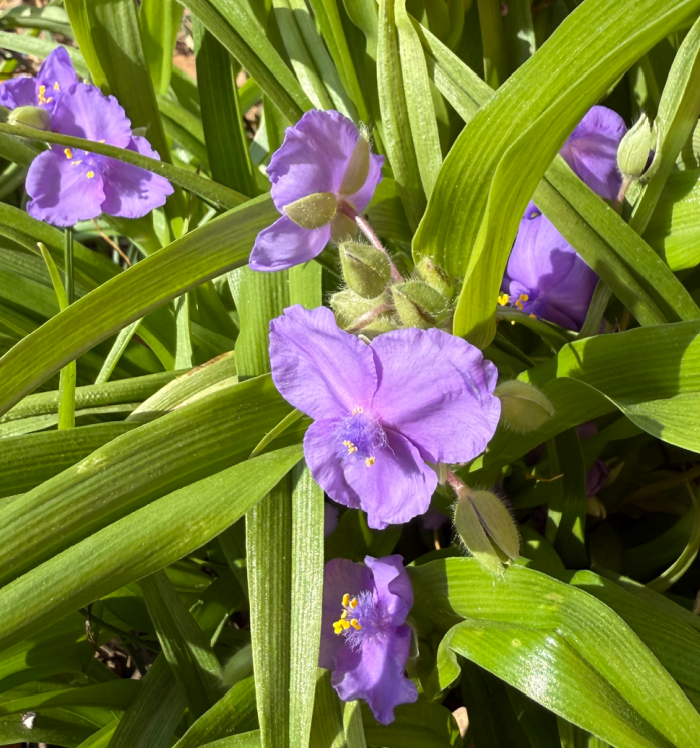During the spring, I am constantly reminded of my love-hate relationship with spiderwort. Bear with me as I try to embrace a more positive attitude about this herbaceous perennial that grows all willy nilly in our flowerbeds. Really, it’s sort of a flowerbed-hog, but I’m trying to tip the scale in favor of love, because who wants to spend so much time living on the hate side?
I sure don’t.
Spiderwort (Tradescantia) does have several good qualities. And today, in the spirit of looking on the bright side, I’m concentrating on those.
The Pros and Cons of Spiderwort
Do you ever make a list of pros and cons before you make a decision about something? I recently did this with Spiderwort. And by the way, there are fourteen hard-to-distinguish varieties growing in Arkansas. I’m not sure which is growing in my yard.
Pros:
- Spiderwort is a happy, hearty, long-bloomer that won’t easily be dissuaded from growing wherever it can find a sliver of earth;
- early-bird pollinators flock to Spiderwort’s sweet nectar (and I am a pollinator cheerleader);
- its mantra surely must be “grow where you are planted” because it happily thrives in a wide-range of growing conditions, never asking for a different view or anything really;
- it has a sweet little face;
- Bambi and his woodland cousins won’t eat it, and here in northwest Arkansas, any deer resistant plant has me reconsidering my view.
Cons:
- Spiderwort can be a bit obnoxious, aggressively spreading and choking out other plants; and,
- it has an unkempt weedy look about it, especially after it blooms.
The pros definitely outweigh the cons, so maybe I should try a little harder to be friends with it. After all, everyone occasionally has an unkempt, weedy looking day. And I have learned to leave it be when growing in certain areas. (But if it pops up and crowds Little Henry Sweetspire or Little Joe Pye, I remove it.)
Beneficially speaking…
Native Americans used it for many medical reasons. The roots are a laxative. A spiderwort brewed tea helped with stomach ailments and “women’s complaints”😂. A spiderwort poultice was used to ease bee stings and insect bites.
With the way things have been going lately, you never know when we might need to forage in our yards for food and medicine. AmIRight?
Spiderwort is practically royalty!
Spiderwort was named after John Tradescant, Sr., who was head gardener for King Charles I of England. So basically, the plant is only one degree from royalty.
The Tradescants (Sr. and Jr.) were “earthly but inspired, dreaming of a well-mulched Eden on the Thames. Father and son traveled to three of the four known continents” to collect plans for the King. Now, the garden they planted in the UK, known as Garden Museum, sits on the bank of the Thames looking across to Parliament. (I’m putting this garden on my bucket list!)
Anyway, I doubt many plants can claim such a pedigree.
One More Thing
Area nurseries actually sell a variety of Spiderwort. This astounds me! And when I see it priced at $8.99, I wonder what I’m failing to grasp. But seriously, if you are on the search for Spiderwort, I can hook you up for FREE.
Same for dandelions.
***
Now that you know everything I know about Spiderwort, I’m curious about two things:
- do you have spiderwort growing in your area of the country?
- have you embraced it?
Grace Grits and Gardening
Farm. Food. Garden. Life.










Spider-wort grows all over the back portion of our yard. I mostly hate it because of its weed phase. But Chris loves it—wouldn’t you know? Thanks for clueing me in on its value. Maybe I can get someone to dig it up carry it off in the night.😆
Haha, it will just come back:))
I have used Spiderwort in flower arrangements and it looks really pretty. It is a good filler to add other flowers . I like it in a small dose but like to keep it in check! I have also seen it for sale in nursery and have wondered the same.
have used Spiderwort in flower arrangements and it looks really pretty. It is a good filler to add other flowers . I like it in a small dose but like to keep it in check! I have also seen it for sale in nursery and have wondered the same.
I do have lots of it growing in a rock garden on the north east side of my house!! I pull it up and give it away, then it blooms and I fall in love with it all over again!
Love this practice!
Spiderwort grows on my mostly wooded property in SE Oklahoma. The blooms are pretty, and when I learned that it has medicinal properties, too, I was happy to have it here. The blooms are also edible and look so pretty in salads! On top of the long stems, they are also lovely additions to flower bouquets.